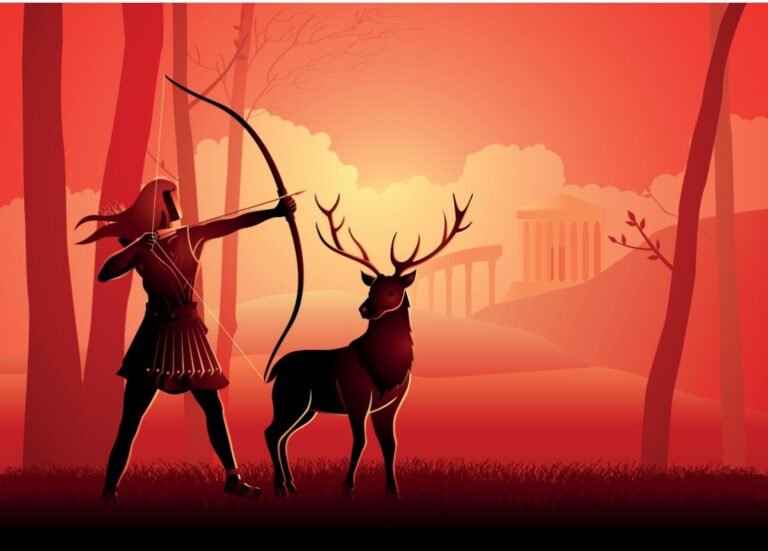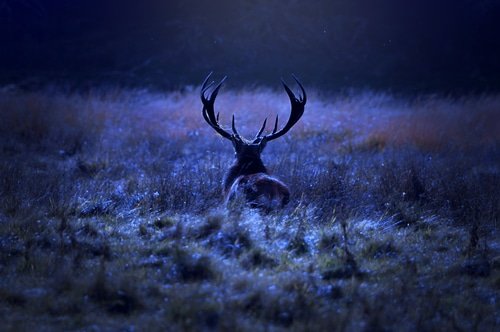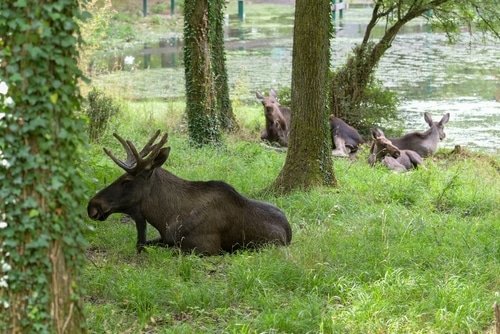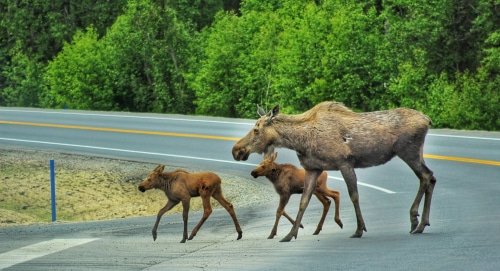In the heart of the dense Canadian wilderness, where towering pines pierce the misty morning skies, an adventure unlike any other beckons to the bold and the brave. Here, in this uncharted domain of nature’s raw beauty, exists the rare and exhilarating opportunity of riding a moose.
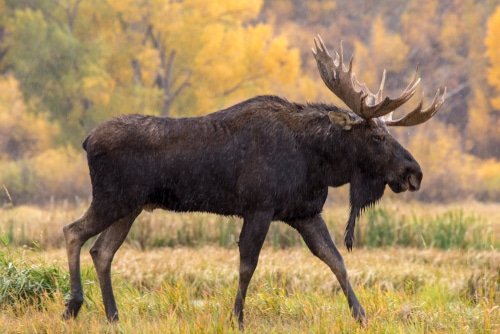
This majestic creature, with its formidable antlers and muscular build, moves with surprising grace through the dense underbrush. To mount a moose is to step into a legend, a thrilling experience that blurs the line between man and the wild, offering a glimpse into an untamed world where the earth’s pulse can be felt beneath its hooves.
With their towering stature and impressive antlers, moose embody a regal presence in the animal kingdom. These gentle giants can reach astonishing heights of up to six and a half feet at their shoulders, making them the largest species in the deer family.
Their magnificent antlers, reminiscent of chandeliers adorned with branches, can span up to 6 feet across. Covered in a thick brownish fur that keeps them cozy during frigid winters, these majestic creatures captivate nature enthusiasts and wildlife lovers alike.
Intriguing Concept of Riding a Moose
Now, let’s delve into an idea that has sparked curiosity among adventure seekers and fanciful dreamers – riding a moose. The notion holds an air of mystique and wonder; how exhilarating would it be to mount one of these majestic creatures and venture through pristine wilderness? However, it’s important to approach this concept cautiously as we must consider various factors, such as moose riding risks and the dangers associated with interacting closely with wild animals.
Through this article, we aim to explore the allure and practicality of riding a moose while highlighting the ethical considerations surrounding such an endeavor. Intrigued?
Let us embark on this extraordinary journey where we’ll discover fascinating details about these extraordinary creatures while exploring if it’s truly possible – or even advisable – to ride a moose. So fasten your seatbelts (metaphorically speaking), for we are about to embark on an adventure filled with knowledge and enchantment!
Moose: The Magnificent Beasts
The Gentle Giants of the North
When it comes to sheer awe-inspiring magnificence, moose take the crown. These majestic creatures are a natural wonder to behold. With their towering stature and enchanting presence, they captivate us with their gentle demeanor and impressive physical features.
Physical Characteristics of Moose
Moose are known for their imposing size, making them the largest members of the deer family. Adult males, called bulls, can reach heights up to 6.5 feet at the shoulder and weigh as much as 1,500 pounds! Their antlers are undoubtedly one of nature’s most striking adornments.
These bony structures can span up to six feet across and possess an intricate maze-like design that varies from one individual to another. Moreover, moose boasts a thick, shaggy coat comprising dark brown fur that keeps them insulated during harsh winters.
Habitat and Distribution
Moose has an impressive geographic range that stretches across Northern Europe, Asia, and North America. They have adapted to thrive in diverse habitats such as dense forests, swamps, and even alpine regions where snow blankets the ground for several months each year. From the boreal forests of Canada to the frozen tundras of Alaska or Siberia, moose endure extreme temperatures and easily navigate challenging terrain.
Fascinating Behaviors and Social Structure
Moose live in small family groups known as herds or sometimes loosely associate in larger aggregations during certain seasons. These herds or aggregations follow a hierarchical social structure led by dominant individuals. Bulls engage in fierce battles during mating season, where they clash antlers in epic displays of strength to establish dominance over rivals and win the affections of receptive females.
Their behaviors are not limited to these thrilling displays of strength but also include fascinating rituals such as wallowing in mud or water to cool off during the hot summer months. Moose are herbivores, feeding on a diverse diet of aquatic plants, grasses, and tree leaves.
Their unique ability to wade through lakes and rivers allows them to access submerged vegetation that other herbivores cannot reach. As we delve deeper into the world of moose, it becomes abundantly clear why these gentle giants have captured the imagination of nature enthusiasts worldwide.
From their physical grandeur to their remarkable adaptability and captivating behaviors, moose reign supreme in the natural kingdom. However, before we venture into moose riding, we must explore the risks and ethical considerations of this extraordinary endeavor.
Riding a Moose: Is it Possible?
Discussion on the Feasibility and Safety Concerns
Regarding riding a moose, feasibility, and safety are two critical considerations. Let’s face it: moose are massive creatures weighing up to 1,500 pounds.
Their sheer size alone poses a challenge for anyone hoping to mount them. Also, moose are known for their unpredictable nature and can become aggressive if threatened or provoked.
This makes riding them an inherently risky endeavor. One of the primary concerns in riding a moose is the potential harm it can cause to the rider and the animal itself.
Moose have powerful hooves and sharp antlers that can cause severe injuries if things go awry during the ride. Moreover, since moose are not domesticated animals like horses or camels, they may lack the training necessary for safe riding.
Historical Anecdotes or Legends about Riding Moose
Throughout history, intriguing tales of individuals attempting to ride these majestic creatures have existed. Although these stories might seem fantastical or exaggerated at times, they speak to our fascination with these gentle giants. Legend has it that indigenous tribes in certain regions had individuals who could successfully ride moose as a part of their cultural traditions.
These skilled riders developed an intimate bond with their chosen moose companion through years of patient observation and mutual respect. While some accounts might be shrouded in myth or folklore, they showcase our long-standing curiosity about interacting with wildlife on such an intimate level.
Legal Implications and Regulations Regarding Interaction with Wildlife
Before entertaining any notions of straddling a magnificent moose’s back, it is essential to consider the legal framework surrounding such interactions. Most countries have stringent regulations to protect wildlife from unnecessary disturbance or harm.
Many jurisdictions categorize moose as protected wildlife, meaning any attempt to ride them can be met with legal consequences. These laws are in place to ensure the safety and well-being of both humans and animals.
It is crucial to research, abide by local wildlife regulations thoroughly, and seek proper permits if engaging in any activities involving moose or other protected species. Remember, while the idea of riding a moose might be thrilling, it is vital to prioritize the welfare of these majestic creatures and respect the legal boundaries that exist for their preservation.
Understanding Moose Behavior for Safe Riding
Insight into the temperament and disposition of moose
When it comes to riding a moose, understanding their temperament and disposition is vital for both your safety and the well-being of these majestic creatures. Moose are generally docile animals, but they can become aggressive if they feel threatened or provoked. It’s essential to remember that moose are wild animals, not domesticated pets.
They have their instincts, behaviors, and boundaries that must be respected. By recognizing that moose are naturally cautious and solitary animals, we can better understand how to approach them with care and respect.
Training methods to establish trust and bond with a moose
Building a bond of trust between rider and moose is critical before attempting any form of riding. Training methods should focus on positive reinforcement rather than forceful or harsh methods.
It is important to note that training a moose requires patience, consistency, and an understanding of their natural behaviors. Establishing trust involves earning the respect of the animal through gentle interactions over time.
Building familiarity through observation and interaction
Observation is key when it comes to understanding moose behavior. Spend time near their habitat without imposing yourself on them directly.
Observe from a distance as they graze or interact with other herd members. This allows you to learn about their body language, vocalizations, and typical activities to anticipate their reactions more effectively when you start training them for riding.
Interaction should be gradual; always approach cautiously while giving them ample space for escape if they show discomfort or agitation. Avoid sudden movements or loud noises, as these may startle the animal unnecessarily.
Establishing clear communication cues between rider and moose
Like any equine partner in traditional horsemanship practices, clear communication cues are essential when riding a moose. Moose are intelligent creatures capable of understanding and responding to human cues, but establishing a common language takes time and patience.
Using consistent signals such as voice commands, subtle body movements, or gentle pressure can help convey your intentions effectively. Remember that moose respond better to calm, assertive energy than forceful commands.
Practice with simple tasks initially, such as leading or stopping the moose on command, before progressing to more complex maneuvers. By developing a clear communication system with your moose companion, you’ll be able to navigate potential obstacles or dangers of riding moose more effectively while ensuring a safer experience for both rider and animal.
Equipment for Riding a Moose
Specially designed saddles or harnesses for safe riding
One cannot rely on any old saddle or harness when riding a moose. These magnificent creatures require specially designed equipment to ensure both the rider’s safety and the moose’s well-being.
A moose saddle is typically made from sturdy materials such as leather or synthetic fibers, with a wide and comfortable seat to distribute the rider’s weight evenly. The saddle must fit snugly on the moose’s back without causing any discomfort or restrictions in movement.
Protective gear for both rider and animal
As with any equestrian activity, riding a moose necessitates protective gear for the rider and the animal. Wearing a well-fitted helmet is essential for the rider to protect against potential head injuries in case of falls or sudden movements.
Additionally, wearing appropriate clothing, such as long pants and sturdy boots, can protect during unexpected encounters with branches or foliage. To ensure the safety of the moose itself, special consideration must be given to its sensitive body parts.
Protective leg coverings made from durable materials can shield their legs from scratches or potential injuries while traversing different terrains. This is especially important when venturing into areas where sharp rocks or dense vegetation may pose risks.
Importance of proper fitting to ensure comfort for the moose
Proper fitting is paramount for equipment used for riding a moose. Ill-fitting saddles or harnesses compromise safety and cause significant discomfort to these majestic creatures.
Our furry friends’ welfare should always precede our desire for adventure. It’s crucial that riders meticulously measure their intended mount before selecting the appropriate equipment size and style.
Too tight saddle may hinder the moose’s mobility and lead to chafing or sores. At the same time, one that’s too loose could shift uncomfortably during movement—ensuring proper padding and cushioning in the saddle comforts our moose companions.
The dangers and risks should never be taken lightly when riding a moose. Riders and animals must have suitable saddles, harnesses, and protective gear.
The comfort and well-being of the moose should always be a priority, reflected in the proper fitting of equipment. So, before mounting these magnificent creatures, let us remember to take all necessary precautions to ensure a safe and enjoyable experience for everyone involved.
Techniques for Mounting and Riding a Moose
Step-by-step guide on mounting a trained moose
Mounting a trained moose requires patience, skill, and respect for these majestic creatures. First, ensure that the moose is calm and comfortable around you. Approach it slowly from the side, speaking softly to alleviate any fears it may have.
Gently place your hand on its withers, the area between its shoulder blades, and apply light pressure to indicate that you want it to lower itself. Once kneeling, grab hold of its mane or harness while carefully positioning one foot in the stirrup on the opposite side. With a swift motion, swing your other leg over its back and settle into the saddle.
Remember to avoid sudden movements or applying excessive pressure, as this may startle or agitate the animal.
Correct posture, balance, and grip while riding
Maintaining proper posture while riding a moose is crucial for comfort and control. Keep your back straight yet relaxed, engaging your core muscles for stability. Distribute your weight evenly over the moose’s back to avoid putting excess pressure on vulnerable areas. Flexibility in your hips will allow you to move smoothly with the moose’s natural gait. As for grip, lightly hold onto either the mane or saddle straps using both hands to maintain balance without pulling or tugging abruptly.
Tips on steering, stopping, and maneuvering
Due to their sensitivity, steering a moose requires subtle cues rather than forceful commands. To go left or right, gently shift your weight towards that direction while softly nudging the reins in that same direction; avoid harsh tugs that may startle or confuse them unnecessarily.
Stopping primarily relies on verbal commands paired with slight backward pressure on their reins; remember to do so gradually and never yank on them abruptly. For maneuvering through obstacles or tight spaces, use your legs and body to guide the moose by leaning slightly in the desired direction without applying excessive pressure. Remember that sudden movements or shouting may spook the moose, potentially endangering you and the animal. Riding a moose has inherent risks, so always prioritize safety and respect their boundaries.
Benefits of Riding a Moose
A unique perspective on nature from atop a majestic creature riding a moose offers an unparalleled vantage point to admire the beauty of nature. Imagine yourself perched atop this magnificent creature, its powerful muscles propelling you through lush forests or serene meadows. From this elevated position, you can immerse yourself in the breathtaking landscapes.
The experience grants a sense of awe as you witness wildlife in their natural habitats, observe birds soaring through the skies, and take in the mesmerizing tapestry of colors during different seasons. It is an adventure that allows you to reconnect with nature in a truly extraordinary way.
Potential therapeutic benefits from bonding with animals
Riding a moose can remarkably benefit individuals seeking solace or healing through animal interactions. Establishing a bond with such an awe-inspiring creature can evoke trust, companionship, and emotional connection.
As you get to know your moose companion and share the trails, there is an opportunity for personal growth and self-reflection. The gentle sway of your ride may provide a soothing rhythm that calms anxieties and reduces stress levels. This unique bond between humans and animals has been known to promote emotional well-being while fostering empathy and compassion.
Opportunities for eco-tourism or wildlife education: moose presents exciting possibilities for eco-tourism ventures and opportunities to educate people about wildlife conservation efforts. By offering guided tours that allow individuals to ride moose responsibly under expert supervision, we can promote appreciation for these incredible creatures while emphasizing the importance of protecting their natural habitats.
Such eco-tourism initiatives create economic incentives for local communities to safeguard their environment while raising awareness about ecological preservation globally. As we explore these benefits, we must acknowledge the potential risks and ethical considerations associated with riding moose.
Responsible and sustainable practices must be implemented to ensure the well-being of riders and these magnificent animals. By prioritizing education, conservation, and safety, we can maximize the benefits while mitigating any negative impacts on moose populations and their habitats.
Ethical Considerations in Riding Moses
Respecting Wildlife and Conservation Efforts
When riding moose, ethical considerations revolve around respecting these magnificent creatures’ natural behavior and well-being. Moose are wild animals that deserve our admiration from a distance, allowing them to live freely in their natural habitat.
Riding moose can disrupt their normal behaviors, cause stress, and potentially harm them physically. Refraining from attempts to ride moose, we can respect their autonomy and contribute to the conservation efforts to preserve their populations for future generations.
Maintaining a Balance between Human Interaction and Wildlife Preservation
As humans, it is essential to find a balance between our desire for adventure and the need to protect wildlife. While it may seem thrilling or exotic to ride a moose, we must consider the potential consequences of such actions.
Interacting with wild animals should prioritize their safety as well as ours. By practicing responsible tourism and engaging in activities that do not intrude upon their natural lives, we can ensure that moose populations remain stable while appreciating their beauty.
Conclusion
Riding a moose may seem exciting, but delving deeper reveals significant ethical considerations. When contemplating such interactions, respect wildlife, support conservation efforts, and balance human desires and wildlife preservation.
Ultimately, we must remember that nature functions best when left undisturbed by human interference. So, let us marvel at the grandeur of these majestic creatures from afar while working towards safeguarding their existence for generations to come.

